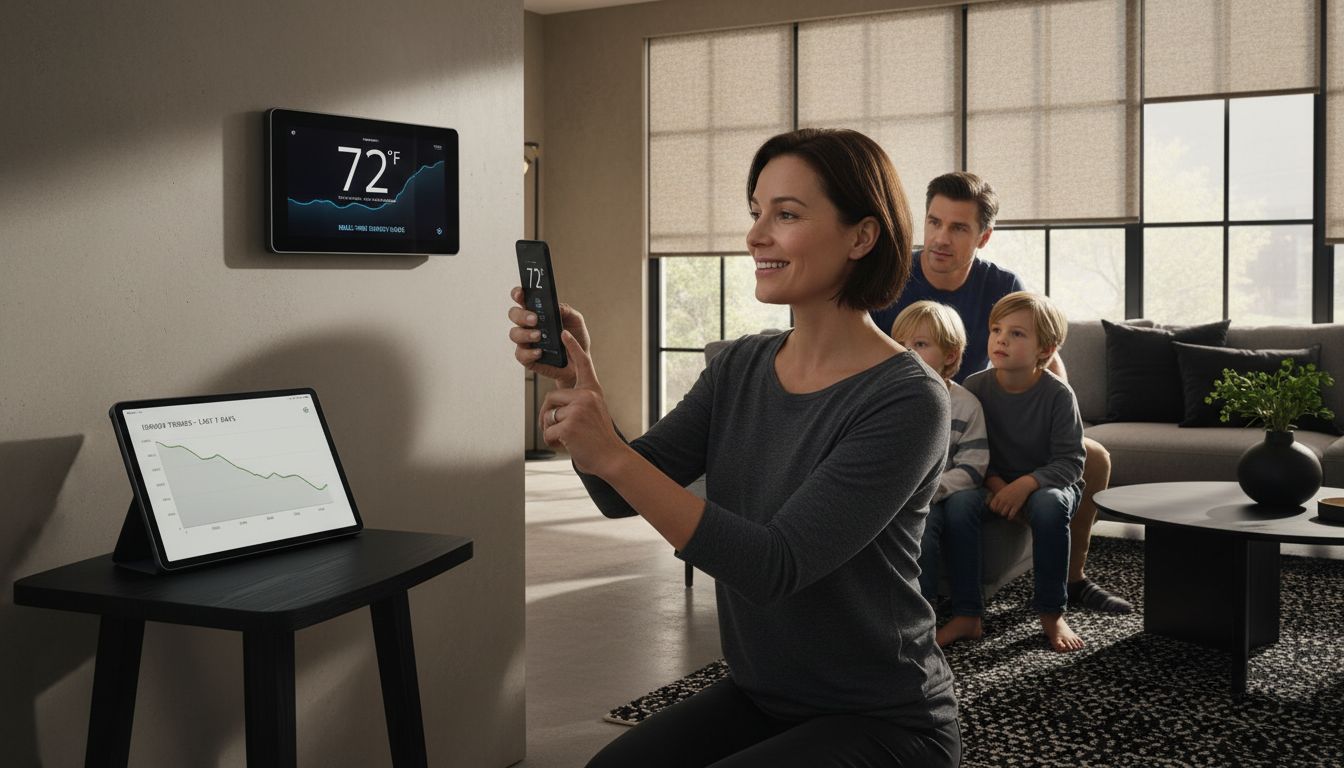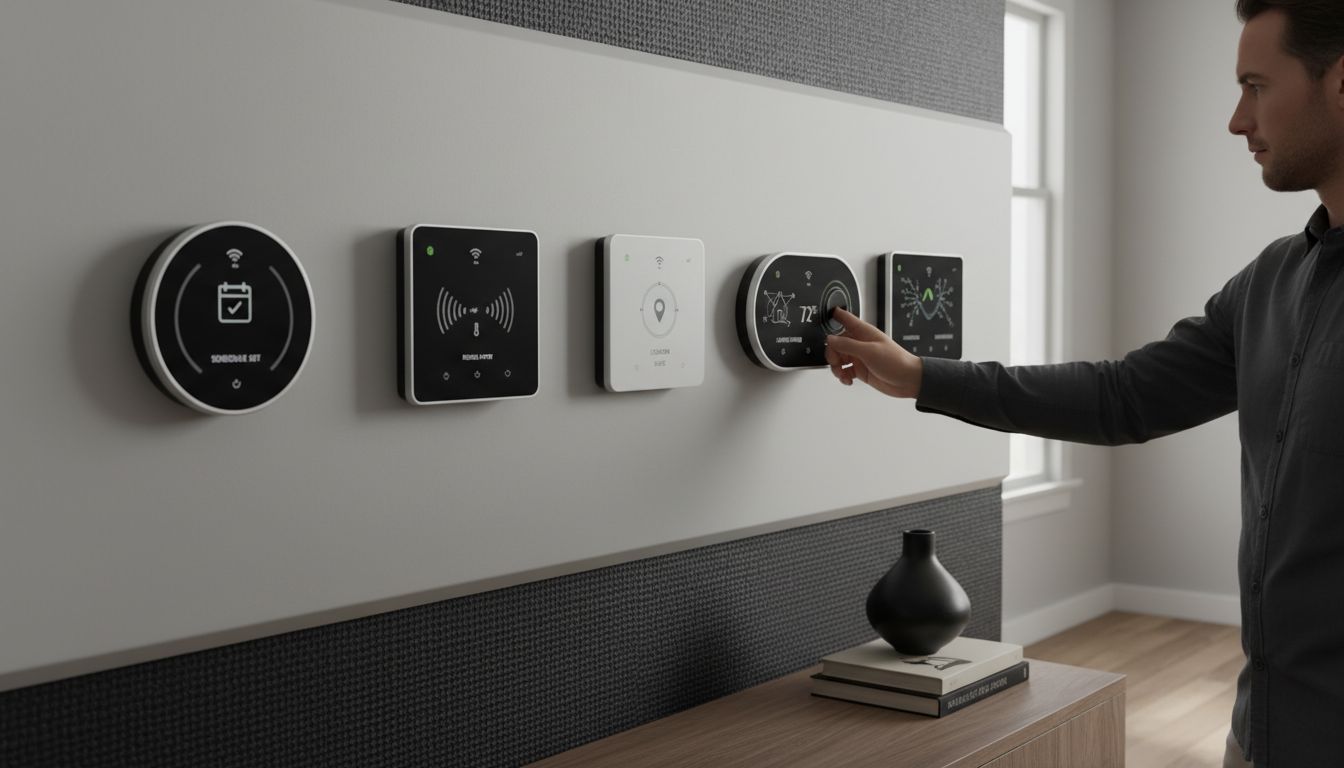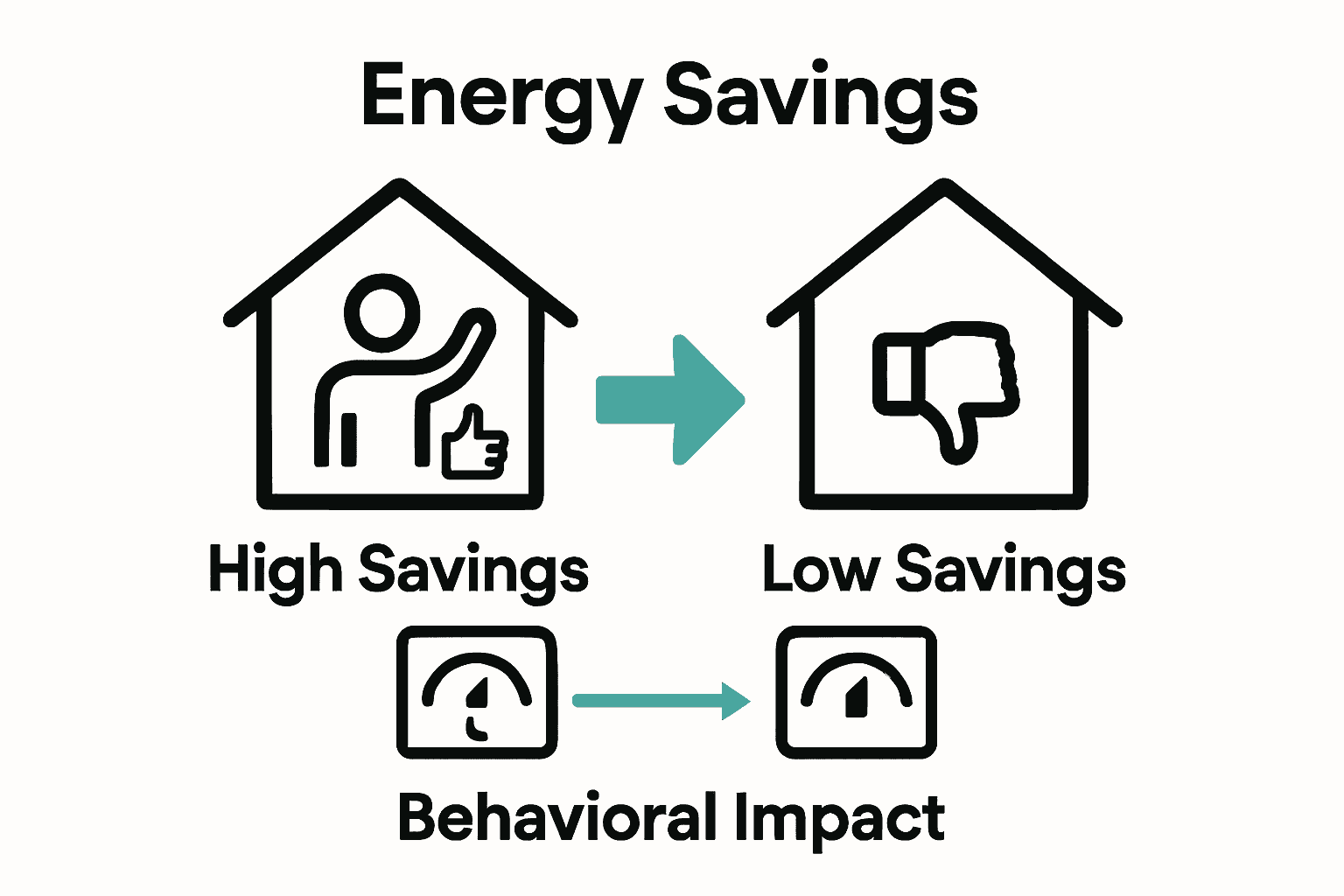
Smart Thermostats for Homes: Everything You Need to Know
Nearly 40 percent of households are now turning to smart thermostats for a smarter, more energy-efficient home. As these intelligent devices reshape how we control comfort, they promise more than remote adjustments or fancy displays. The real advantage lies in their ability to adapt to your unique schedule and save on energy bills. If you’re curious about transforming your home’s climate control, a closer look at smart thermostats could change how you think about efficiency and convenience.
Table of Contents
- What Smart Thermostats Mean
- Smart Thermostat Types Explained
- How Smart Thermostats Work
- Energy Savings and User Behavior
- Compatibility and Installation Requirements
- Privacy Risks and Security Considerations
Key Takeaways
| Point | Details |
|---|---|
| Energy Efficiency | Smart thermostats optimize energy usage by learning household patterns, potentially lowering energy bills. |
| Compatibility Check | Assess HVAC compatibility, Wi-Fi stability, and electrical requirements before installation to ensure optimal performance. |
| User Engagement | Successful use relies on consistent interaction and trust in the device, which can significantly impact energy savings. |
| Privacy Awareness | Understand data privacy risks and adopt security measures, including reviewing privacy policies and using strong passwords. |
What Smart Thermostats Mean
Smart thermostats represent a technological leap in home climate management, transforming how homeowners interact with their heating and cooling systems. According to Wikipedia, these Wi-Fi-enabled devices control home HVAC systems with unprecedented precision and connectivity.
At their core, smart thermostats do far more than traditional temperature controls. They learn your household’s unique patterns, allowing remote temperature adjustments through internet-connected devices. Key features typically include:
- Automatic schedule recognition
- Remote smartphone control
- Detailed energy usage reporting
- Integration with weather forecasts
- Machine learning capabilities to optimize comfort
The real magic happens in their ability to optimize energy efficiency. Research from arXiv highlights that smart thermostats analyze heating patterns to significantly reduce energy consumption. A comprehensive study across five European countries revealed that individual beliefs about performance and price value play crucial roles in technology adoption.
Beyond convenience, smart thermostats represent a meaningful step towards intelligent, responsive home environments. They transform static temperature controls into dynamic systems that adapt to your lifestyle, potentially reducing energy bills and increasing home comfort simultaneously.
Smart Thermostat Types Explained
Smart thermostats have evolved into diverse categories, each designed to meet specific home comfort and energy management needs. According to Wikipedia, these innovative devices can be classified into several distinct types that offer unique functionalities for homeowners.
The primary categories of smart thermostats include:
Here’s a comparison of the main types of smart thermostats and their key features:
| Type of Smart Thermostat | Key Functionality | Typical Use Case |
|---|---|---|
| Learning Thermostat | Adapts to routines Optimizes automatically |
Busy households Frequent changes |
| Programmable Thermostat | Manual schedule settings Simple timer control |
Consistent routine Basic needs |
| Remote Sensor Thermostat | Multi-room temperature monitoring | Large homes Room-by-room comfort |
| Geofencing Thermostat | Adjusts based on smartphone location | Commuters Mobile households |
| Ecosystem-Integrated Thermostat | Connects to smart home systems | Smart home users Automation fans |
- Learning Thermostats: Automatically adapt to household routines and preferences
- Programmable Thermostats: Allow manual scheduling of temperature changes
- Remote Sensor Thermostats: Monitor temperature across multiple rooms
- Geofencing Thermostats: Adjust temperatures based on occupants’ smartphone locations
- Ecosystem-Integrated Thermostats: Connect seamlessly with broader smart home systems
Research from International Journal of Scientific Research highlights that modern smart thermostats are categorized based on advanced features like Wi-Fi connectivity, machine learning algorithms, and occupancy detection. These sophisticated devices go beyond simple temperature control, offering intelligent energy management that can significantly reduce household utility costs.
Choosing the right smart thermostat depends on your specific needs. Some prioritize precise scheduling, while others focus on learning and adapting to your lifestyle. The key is finding a device that balances convenience, energy efficiency, and compatibility with your existing home technology infrastructure.

How Smart Thermostats Work
Smart thermostats are sophisticated devices that transform traditional temperature control into an intelligent, adaptive system. According to Wikipedia, these devices operate by connecting to Wi-Fi networks, enabling seamless remote control through smartphones and computers.
The core functionality of smart thermostats revolves around their advanced sensor technologies. They continuously collect and analyze data about:
- Room occupancy
- Current temperature
- Humidity levels
- User behavior patterns
- External weather conditions
Research from arXiv reveals an even more impressive capability of these devices. Beyond basic temperature management, smart thermostats can monitor ambient conditions to detect potential HVAC system issues like refrigerant leaks. By analyzing data from built-in sensors, they can identify anomalies early, enabling proactive maintenance and preventing energy waste.
The magic happens through machine learning algorithms that progressively understand your preferences. Over time, these devices learn when you typically wake up, leave home, or prefer different temperatures. They automatically adjust settings to optimize both comfort and energy efficiency, creating a personalized climate control experience that adapts to your unique lifestyle.
Energy Savings and User Behavior
Smart thermostats are more than just temperature control devices. They represent a sophisticated approach to energy management that deeply intertwines technology with human behavior. According to Wikipedia, the potential for energy savings hinges critically on how users interact with these intelligent systems.
The potential energy savings can be substantial, but they depend on several key factors:
- Accurate initial programming
- Consistent user engagement
- Willingness to trust automated recommendations
- Understanding of system capabilities
- Minimal manual temperature overrides
Research from arXiv reveals a fascinating insight into user behavior. Many occupants frequently override thermostat settings due to personal discomfort or a lack of trust in automation. This human element significantly impacts the energy efficiency potential of smart thermostats, suggesting that devices must become more intuitive and responsive to individual preferences.
To maximize energy savings, users need to view their smart thermostat as a collaborative tool rather than a fixed system. This means being open to gradual temperature adjustments, understanding the long-term benefits of slight comfort compromises, and allowing the device’s learning algorithms to optimize energy consumption. The most successful implementations occur when technology adapts to human behavior, not the other way around.

Compatibility and Installation Requirements
Smart thermostats represent a complex technology that demands careful consideration before installation. According to Wikipedia, successful implementation hinges on understanding your existing home infrastructure and ensuring seamless technological integration.
Before purchasing a smart thermostat, homeowners must evaluate several critical compatibility factors:
- HVAC system specifications
- Electrical wiring configuration
- Wi-Fi network stability
- Voltage requirements
- Smart home ecosystem compatibility
- Power source availability (C-wire)
Research from the International Journal of Scientific Research emphasizes that successful installation depends on multiple technical considerations. Most smart thermostats require a stable internet connection and specific electrical configurations to function optimally. The infamous C-wire (common wire) becomes crucial, providing continuous power to enable advanced features like smartphone connectivity and continuous learning algorithms.
Professional installation might be recommended for complex home setups, especially for older HVAC systems or homes with non-standard electrical configurations. While many smart thermostats market themselves as DIY-friendly, the nuanced compatibility requirements mean that a professional assessment can prevent potential technical complications and ensure maximum performance from your investment.
Privacy Risks and Security Considerations
Smart thermostats introduce a complex landscape of digital privacy and security challenges that extend far beyond simple temperature control. According to Wikipedia, these devices collect extensive data on user habits and home occupancy, raising significant privacy concerns for tech-savvy homeowners.
The primary privacy risks associated with smart thermostats include:
- Detailed tracking of home occupancy patterns
- Potential unauthorized data sharing
- Vulnerability to cyber intrusions
- Comprehensive behavioral profiling
- Potential location data exposure
- Risk of third-party data monetization
Research from arXiv highlights that users’ trust in these devices fundamentally depends on transparent data handling practices. The study emphasizes that data privacy is not just a technical issue, but a critical factor in user adoption and comfort with smart home technologies.
To mitigate these risks, homeowners should adopt a proactive approach. This means carefully reviewing manufacturer privacy policies, using strong, unique passwords, regularly updating device firmware, and being selective about the permissions granted to smart thermostat applications. Understanding that every connected device is a potential entry point for cyber threats is the first step in maintaining your digital home security.
Enhance Your Home’s Comfort and Efficiency with Smart Window Treatments
Integrating smart thermostats into your home is a powerful step to optimize energy savings and personalized comfort. But to truly maximize these benefits, your windows play a crucial role in controlling heat and light effectively. Many homeowners overlook how smart window treatments like cellular shades or motorized blinds can complement your smart thermostat by enhancing insulation, reducing energy loss, and even automating sunlight exposure.

Discover custom, energy-efficient solutions designed to work alongside your smart HVAC system at Value Blinds. With features like cordless operation for safety, blackout fabrics for ultimate comfort, and motorized options for seamless control, you can create a smarter, more comfortable home environment today. Don’t wait to experience the perfect blend of technology and style that transforms your space and lowers energy costs. Explore our full collection now and take the first step toward a smarter home at Value Blinds Direct.
Frequently Asked Questions
What are smart thermostats and how do they work?
Smart thermostats are Wi-Fi-enabled devices that manage home heating and cooling systems. They connect to the internet, allowing for remote control via smartphones and computers. They continuously collect data on room occupancy, temperature, and user behavior, using machine learning to optimize comfort and energy efficiency.
What types of smart thermostats are available?
There are several types of smart thermostats, including learning thermostats that adapt to routines, programmable thermostats with manual scheduling, remote sensor thermostats for multi-room monitoring, geofencing thermostats that adjust based on your location, and ecosystem-integrated thermostats that connect to broader smart home systems.
How can smart thermostats save energy?
Smart thermostats save energy by learning your preferences and adjusting temperatures accordingly. They analyze usage patterns and can optimize heating and cooling schedules, leading to reduced energy consumption and potentially lower energy bills.
What are the privacy and security risks associated with smart thermostats?
Smart thermostats collect detailed data on user habits and home occupancy, which can pose privacy risks including unauthorized data sharing and cyber intrusions. To mitigate these risks, users should carefully review privacy policies, use strong passwords, and keep their devices updated.







